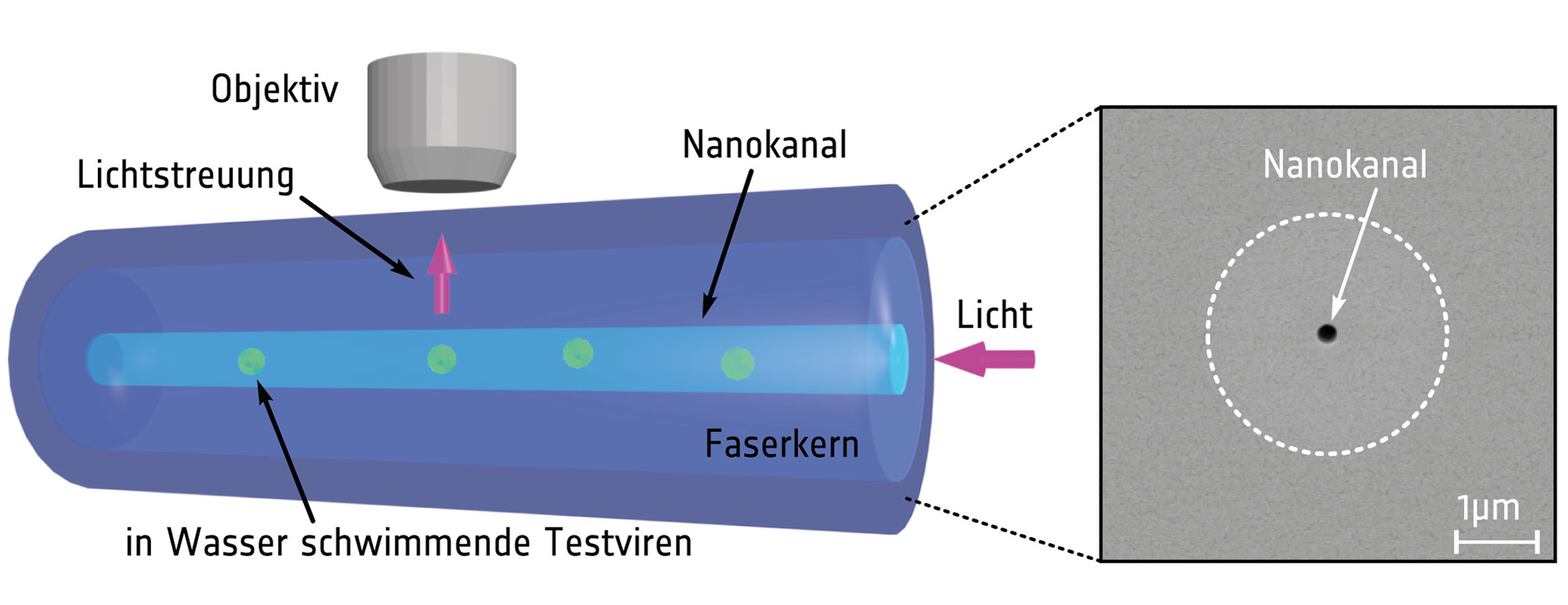Marker-free Detection of Viruses Using Fibers

In light of the increase in viral diseases, a fast and unambiguous detection of viruses is becoming increasingly important. Virological diagnostics provides a number of possibilities, but the viruses need to be fixated and stained. At Leibniz-IPHT, a fiber was developed which allows the label-free determination of the size and movement of freely diffusing viruses with dimensions smaller than 20 nanometers.
 Viruses are very small: Their diameter is between 20 and 200 nanometers. Thus, viruses are much smaller than a human hair, which is 100,000 to 200,000 nanometers thick. Because of their size, objects of less than 100 nanometers often elude conventional characterization methods. Therefore, viruses that are present in high quantity are usually made visible by an electron microscope after fixation and staining with a fluorescent dye or binding of fluorescently labeled antibodies. However, marking a virus with a dye changes its properties.
Viruses are very small: Their diameter is between 20 and 200 nanometers. Thus, viruses are much smaller than a human hair, which is 100,000 to 200,000 nanometers thick. Because of their size, objects of less than 100 nanometers often elude conventional characterization methods. Therefore, viruses that are present in high quantity are usually made visible by an electron microscope after fixation and staining with a fluorescent dye or binding of fluorescently labeled antibodies. However, marking a virus with a dye changes its properties.
“Part of our work concentrates on the implementation of nano and microstructured elements in fibers for the biophotonics research focus. Therefore, we have pondered how we can utilize this expertise to employ fibers in the long-term measurement of freely diffusing, marker-free viruses,” said Professor Dr. Markus Schmidt, head of the fiber sensor research group. Together with colleagues from the University of Leiden (Netherlands) and his team, he designed a novel type of fiber. A nanohole with a diameter of 200 nanometers in the core extends along the entire fiber. Test viruses floating in water are introduced to this hole and light is coupled into the fiber core. The refractive index of the water is always smaller than that of the quartz glass core surrounding it. However, the basis for guiding light in an optical fiber is a refractive index that is decreasing from core to cladding.
“Our partner Heraeus Quarzglas developed a custom fiber for us by increasing the refractive index of the quartz glass around the nanohole in a targeted manner with the help of dopants in order to generate a core region. As a result, the coupled light in the fiber core does not break out at the interface to the undoped quartz glass cladding but remains trapped in the fiber.” says Schmidt.
 If the light coupled into the capillary hits a virus, a portion of the light is deflected from its direction of propagation (i. e., scattered). Based on this light scattering and using a microscope, the size of the virus can be determined. In addition, the movement of a virus can be observed and recorded over a period of up to 10 seconds.
If the light coupled into the capillary hits a virus, a portion of the light is deflected from its direction of propagation (i. e., scattered). Based on this light scattering and using a microscope, the size of the virus can be determined. In addition, the movement of a virus can be observed and recorded over a period of up to 10 seconds.
The first measurements of the test viruses were carried out at the University of Harvard, USA, and the University of Leiden, Netherlands.
The fiber developed can be integrated into standard microscopes, thereby extending their detection range to other nanoparticles. Applications range from medical diagnostics to drinking water analysis.






